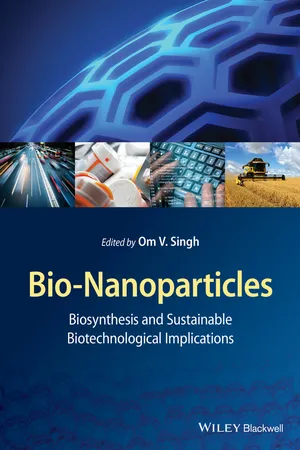
Bio-Nanoparticles
Biosynthesis and Sustainable Biotechnological Implications
Om V. Singh, Om V. Singh
- English
- ePUB (mobile friendly)
- Available on iOS & Android
Bio-Nanoparticles
Biosynthesis and Sustainable Biotechnological Implications
Om V. Singh, Om V. Singh
About This Book
Nanoparticles are the building blocks for nanotechnology; they are better built, long lasting, cleaner, safer, and smarter products for use across industries, including communications, medicine, transportation, agriculture and other industries. Controlled size, shape, composition, crystallinity, and structure-dependent properties govern the unique properties of nanotechnology.
Bio-Nanoparticles: Biosynthesis and Sustainable Biotechnological Implications explores both the basics of and advancements in nanoparticle biosynthesis. The text introduces the reader to a variety of microorganisms able to synthesize nanoparticles, provides an overview of the methodologies applied to biosynthesize nanoparticles for medical and commercial use, and gives an overview of regulations governing their use.
Authored by leaders in the field, Bio-Nanoparticles: Biosynthesis and Sustainable Biotechnological Implications bridges the gap between biology and technology, and is an invaluable resource for students and researchers alike.
Frequently asked questions
Information
1
DIVERSITY OF MICROBES IN SYNTHESIS OF METAL NANOPARTICLES: PROGRESS AND LIMITATIONS
1.1. Introduction
1.2. Synthesis of Nanoparticles by Bacteria

| Metallic material | Bacteria (reference) | ...
Table of contents
- COVER
- TITLE PAGE
- TABLE OF CONTENTS
- LIST OF CONTRIBUTORS
- INTRODUCTION
- 1 DIVERSITY OF MICROBES IN SYNTHESIS OF METAL NANOPARTICLES: PROGRESS AND LIMITATIONS
- 2 ROLE OF FUNGI TOWARD SYNTHESIS OF NANO-OXIDES
- 3 MICROBIAL MOLECULAR MECHANISMS IN BIOSYNTHESIS OF NANOPARTICLES
- 4 BIOFILMS IN BIO-NANOTECHNOLOGY: OPPORTUNITIES AND CHALLENGES
- 5 EXTREMOPHILES AND BIOSYNTHESIS OF NANOPARTICLES: CURRENT AND FUTURE PERSPECTIVES
- 6 BIOSYNTHESIS OF SIZE-CONTROLLED METAL AND METAL OXIDE NANOPARTICLES BY BACTERIA
- 7 METHODS OF NANOPARTICLE BIOSYNTHESIS FOR MEDICAL AND COMMERCIAL APPLICATIONS
- 8 MICROBIAL SYNTHESIS OF NANOPARTICLES: AN OVERVIEW
- 9 MICROBIAL DIVERSITY OF NANOPARTICLE BIOSYNTHESIS
- 10 SUSTAINABLE SYNTHESIS OF PALLADIUM(0) NANOCATALYSTS AND THEIR POTENTIAL FOR ORGANOHALOGEN COMPOUNDS DETOXIFICATION
- 11 ENVIRONMENTAL PROCESSING OF Zn CONTAINING WASTES AND GENERATION OF NANOSIZED VALUE-ADDED PRODUCTS
- 12 INTERACTION BETWEEN NANOPARTICLES AND PLANTS: INCREASING EVIDENCE OF PHYTOTOXICITY
- 13 CYTOTOXICOLOGY OF NANOCOMPOSITES
- 14 NANOTECHNOLOGY: OVERVIEW OF REGULATIONS AND IMPLEMENTATIONS
- NAME INDEX
- SUBJECT INDEX
- END USER LICENSE AGREEMENT